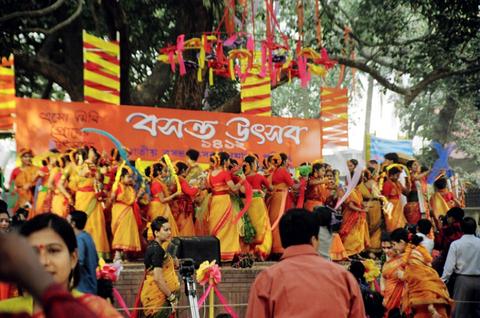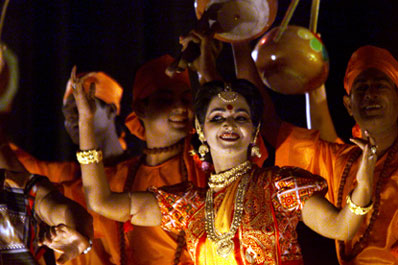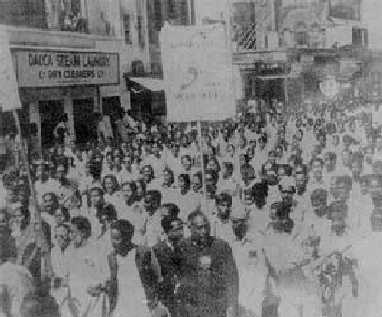|
Phalgun
Falgun or Phalgun (; ne, फाल्गुण) or Phagun ( as, ফাগুন) is the eleventh month of the year in the Bengali calendar, the Assamese calendar, and the Nepali calendar. In the revision of the Bengali calendar used in Bangladesh since October 2019, the month has 29 days in common years or 30 in leap years of the Gregorian calendar. In the previous version of the calendar, used in Bangladesh from 1987 through October 2019, Falgun had 30 days in common years or 31 days in leap years. The month has 29 or 30 days, based on the true movements of the Sun, in the old non-reformed Bengali calendar, still used in West Bengal, and in the Nepali calendar. Falgun was named for the '' nakshatra'' (lunar mansion) ''Uttara phalguni'', in the vicinity of which the full moon appears at that time of the year. It marks the arrival of spring, the sixth and final season in Bangladesh, West Bengal, Assam, and Nepal. Falgun falls between mid-February and mid-March on the Gregorian cal ... [...More Info...] [...Related Items...] OR: [Wikipedia] [Google] [Baidu] |
Holi
Holi (), also known as the Festival of Colours, the Festival of Spring, and the Festival of Love,The New Oxford Dictionary of English (1998) p. 874 "Holi /'həʊli:/ noun a Hindu spring festival ...". is an ancient Hindu religious festival and one of the most popular festivals in Hinduism. It celebrates the eternal and divine love of Radha Krishna. The day also signifies the triumph of good over evil, as it commemorates the victory of Lord Vishnu as Narasimha Narayana over Hiranyakashipu. It originated and is predominantly celebrated in the Indian subcontinent but has also spread to other regions of Asia and parts of the Western world through the Indian diaspora.Ebeling, Karin (10), Holi, an Indian Festival, and its Reflection in English Media; Die Ordnung des Standard und die Differenzierung der Diskurse: Akten des 41. Linguistischen Kolloquiums in Mannheim 2006, 1, 107, [...More Info...] [...Related Items...] OR: [Wikipedia] [Google] [Baidu] |
Nakshatra
Nakshatra ( sa, नक्षत्रम्, translit=Nakṣatram) is the term for lunar mansion in Hindu astrology and Indian Astronomy. A nakshatra is one of 27 (sometimes also 28) sectors along the ecliptic. Their names are related to a prominent star or asterisms in or near the respective sectors. The starting point for the nakshatras according to Vedas is "Krittika" (it has been argued because the Pleiades may have started the year at the time the Vedas were compiled, presumably at the vernal equinox), but, in more recent compilations, the start of the nakshatras list is the point on the ecliptic directly opposite to the star Spica called ''Chitrā'' in Sanskrit, which would be Ashwinī, a part of the modern constellation Aries, and these compilations therefore may have been compiled during the centuries when the sun was passing through the area of the constellation Aries at the time of the vernal equinox. This version may have been called ''Meshādi'' or the " start ... [...More Info...] [...Related Items...] OR: [Wikipedia] [Google] [Baidu] |
Maha Shivaratri
Maha Shivaratri (IAST: Mahāśivarātri) is a Hindu festival celebrated annually in honour of the god Shiva. The name also refers to the night when Shiva performs the heavenly dance called Tandava. In every month of the luni-solar Hindu calendar, there is a ''Shivaratri'' – "night of Shiva" – on the day before new moon. But once a year, in late winter and before the arrival of Summer (February/March), this night is called "Maha Shivaratri" – "the Great Night of Shiva". This day falls in the month of Phalguna as per the North Indian Hindu calendar and in Magha as per the South Indian Hindu calendar (see Amanta and Purnimanta systems). It is a notable festival in Hinduism, and this festival is solemn and marks a remembrance of "overcoming darkness and ignorance" in life and the world. It is observed by remembering Shiva and chanting prayers, fasting, and meditating on ethics and virtues such as honesty, non-injury to others, charity, forgiveness, and the discovery of ... [...More Info...] [...Related Items...] OR: [Wikipedia] [Google] [Baidu] |
Dol Yatra
Dol Purnima, Dol Jatra, Doul Utsav or Deul is a major Holi festival of Braj, Bangladesh and the Indian state of West Bengal, Odisha and Assam. This festival is dedicated to Sri Krishna and Radha. It is mainly celebrated by Gopal community of Odisha. On this auspicious day, a deity of Krishna and his beloved Radha, richly adorned and besmeared with colored powder ( Abir. In Brajvasi, Bengali, Odia and Assamese, is taken out in procession in a swinging palanquin, decorated with flowers, leaves, colored clothes and papers. The procession proceeds forward to the accompaniment of music, blaring of conch shells, trumpets made from water buffalo horn and shouts of 'Joy' (Victory) and 'Hôri Bolo' in Odisha. Odia women wash their courtyards with cowdung and decorate with rice powder and flowers. Milk items like home made curd, cream, butter and 'panchamrit' are offered. The people who accompany are offered sweets and drinks. In villages, drinks made of curd are distributed among people and ... [...More Info...] [...Related Items...] OR: [Wikipedia] [Google] [Baidu] |
Bikram Sambat
Vikram Samvat (IAST: ''Vikrama Samvat''; abbreviated VS) or Bikram Sambat B.S. and also known as the Vikrami calendar, is a Hindu calendar historically used in the Indian subcontinent. Vikram Samvat is generally 57 years ahead of Gregorian Calendar, except during January to April, when it is ahead by 56 years. Alongside Nepal Sambat, it is one of the two official calendars used in Nepal. In India, it is used in several states. The traditional Vikram Samvat calendar, as used in India, uses lunar months and solar sidereal years. The Nepali Bikram Sambat introduced in 1901 CE, also uses a solar sidereal year. History A number of ancient and medieval inscriptions used the Vikram Samvat. Although it was reportedly named after the legendary king Vikramaditya, the term "Vikrama Samvat" does not appear in the historical record before the 9th century; the same calendar system is found with other names, such as Krita and Malava. In colonial scholarship, the era was believed to be bas ... [...More Info...] [...Related Items...] OR: [Wikipedia] [Google] [Baidu] |
Magh (Bengali Calendar)
Magh ( bn, মাঘ) is the tenth month in the Bengali calendar. This is the last month of the two months of winter season. Etymology This month is named after the star Magha ( ''Môgha''). Festivals * ''Maghi Purnima'', a Buddhist festival on the full moon night of this month * ''Suryavrata'', a vrata observed by Hindu women usually who are unmarried, on the first day of this month * ''Saraswati puja'', Hindu festival in honor of goddess Saraswati observed on the fifth lunar day in this month, popular in Bangladesh, and Assam and West Bengal states of India. Observances * Suryavrata - Magh 1 * Republic Day of India and Australia Day - Magh 12 (India), Magh 11 (Bangladesh) * Super Bowl Sunday Super Bowl Sunday, officially Super Sunday in the NFL, is the day on which the Super Bowl, the National Football League (NFL)'s annual championship game, is played. Sometimes described as an unofficial national holiday, it recently occurred on t ... - Fourth Sunday of Magh Refere ... [...More Info...] [...Related Items...] OR: [Wikipedia] [Google] [Baidu] |
Assam
Assam (; ) is a state in northeastern India, south of the eastern Himalayas along the Brahmaputra and Barak River valleys. Assam covers an area of . The state is bordered by Bhutan and Arunachal Pradesh to the north; Nagaland and Manipur to the east; Meghalaya, Tripura, Mizoram and Bangladesh to the south; and West Bengal to the west via the Siliguri Corridor, a wide strip of land that connects the state to the rest of India. Assamese and Boro are the official languages of Assam, while Bengali is an additional official language in the Barak Valley. Assam is known for Assam tea and Assam silk. The state was the first site for oil drilling in Asia. Assam is home to the one-horned Indian rhinoceros, along with the wild water buffalo, pygmy hog, tiger and various species of Asiatic birds, and provides one of the last wild habitats for the Asian elephant. The Assamese economy is aided by wildlife tourism to Kaziranga National Park and Manas National Park, which are ... [...More Info...] [...Related Items...] OR: [Wikipedia] [Google] [Baidu] |
Culture Of Bangladesh
The culture of Bangladesh is intertwined with the culture of the ''Bengal region'' of the Indian subcontinent. It has evolved over the centuries and encompasses the cultural diversity of several social groups of Bangladesh. The Bengal Renaissance of the 18th early 19th centuries, noted Bengali writers, saints, authors, scientists, researchers, thinkers, music composers, painters, film-makers have played a significant role in the development of Bengali culture. The Bengal Renaissance contained the seeds of a nascent political Indian nationalism which was the precursor in many ways to modern Indian artistic cultural expression. According to M. Nazrul Islam Tamij, a human rights activist and chairman of the National Human Rights Society (NHRS), human rights are the most important part of Bengali culture, and it plays an important role in the development of Bengali culture. The cultures of Bangladesh composite over the centuries have assimilated influences of Islam, Hinduism, ... [...More Info...] [...Related Items...] OR: [Wikipedia] [Google] [Baidu] |
Bangla Calendar
The Bengali Calendar or Bangla Calendar ( bn, বঙ্গাব্দ , , Baṅgābda), colloquially ( bn, বাংলা সন, Baṅgla Śon), is a solar calendar used in the Bengal region of the Indian subcontinent. A revised version of the calendar is the national and official calendar in Bangladesh and an earlier version of the calendar is followed in the Indian states of West Bengal, Tripura and Assam. The New Year in the Bengali calendar is known as ''Pohela Boishakh''. The Bengali era is called ''Bengali Sambat'' (BS) or the ''Bengali year'' ( ''Bangla Sôn'', ''Bangla sal'', or ''Bangabda'') has a zero year that starts in 593/594 CE. It is 594 less than the AD or CE year in the Gregorian calendar if it is before ''Pôhela Bôishakh'', or 593 less if after ''Pôhela Bôishakh''. The revised version of the Bengali calendar was officially adopted in Bangladesh in 1987. Among the Bengali community in India, the traditional Indian Hindu calendar continues to be in use ... [...More Info...] [...Related Items...] OR: [Wikipedia] [Google] [Baidu] |
International Mother Language Day
International Mother Language Day is a worldwide annual observance held on 21 February to promote awareness of linguistic and cultural diversity and to promote multilingualism. First announced by UNESCO on 17 November 1999, it was formally recognized by the United Nations General Assembly with the adoption of UN resolution 56/262 in 2002. Mother Language Day is part of a broader initiative "to promote the preservation and protection of all languages used by peoples of the world" as adopted by the UN General Assembly on 16 May 2007 in UN resolution 61/266, which also established 2008 as the International Year of Languages. The idea to celebrate International Mother Language Day was the initiative of Bangladesh. In Bangladesh, 21 February is the anniversary of the day when the people of Bangladesh (then East Pakistan) fought for recognition for the Bangla language. It is also celebrated in West Bengal, India. History 21 February was declared to be the International Mother L ... [...More Info...] [...Related Items...] OR: [Wikipedia] [Google] [Baidu] |
Language Martyrs' Day
(''Bhasha Andolôn Dibôs'') , nickname = bn, শহীদ দিবস (''Shôhid Dibôs'') , duration = 1 day , frequency = Annual , observedby = Bangladesh and Bengali speakers in India and elsewhere , date = 21 February , firsttime = 1955 , celebrations = Flag hoisting, parades, singing patriotic songs, the ''Amar Bhaier Rokte Rangano'', speeches by the President and Prime Minister, entertainment and cultural programs. , observances = , relatedto = International Mother Language Day Language Movement Day ( bn, ভাষা আন্দোলন দিবস ''Bhasha Andolôn Dibôs''), also called State Language Day or Language Martyrs' Day ( bn, শহীদ দিবস ''Shôhid Dibôs''), is a national holiday of Bangladesh taking place on 21 February each year and commemorating the Bengali language movement and its martyrs. On this day, people visit Shaheed Minar to pay homage to the movement's martyrs and arrange seminars discussin ... [...More Info...] [...Related Items...] OR: [Wikipedia] [Google] [Baidu] |
Democracy Day (Nepal)
The 2006 Democracy Movement ( ne, text=लोकतन्त्र आन्दोलन, translit=Loktantra Āndolan) is a name given to the political agitations against the direct and undemocratic rule of King Gyanendra of Nepal. The movement is also sometimes referred to as ''Jana Andolan II'' ("People's Movement II"), implying it being a second phase of the 1990 Jana Andolan. Reinstitution of Parliament In a nationally televised address, King Gyanendra reinstated the old Nepal House of Representatives on April 24, 2006. The King called upon the Seven Party Alliance (SPA) to bear the responsibility of taking the nation on the path to national unity and prosperity while ensuring permanent peace and safeguarding multiparty democracy. The reinstitution of Parliament was accepted by the SPA. It declared that Girija Prasad Koirala would lead the new government. The SPA stated that the new parliament will hold elections for a body that would write a new constitution. The move wa ... [...More Info...] [...Related Items...] OR: [Wikipedia] [Google] [Baidu] |


.jpg)





